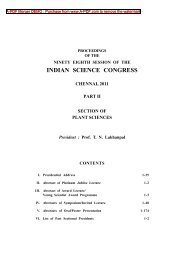sustainable use of biological diversity.pdf - India Environment Portal
sustainable use of biological diversity.pdf - India Environment Portal
sustainable use of biological diversity.pdf - India Environment Portal
Create successful ePaper yourself
Turn your PDF publications into a flip-book with our unique Google optimized e-Paper software.
Agr<strong>of</strong>orestry homegardens in rural landscapes <strong>of</strong> Bangladesh<br />
findings also show the potential <strong>of</strong> carbon sequestration,<br />
thus contribute to reduce atmospheric carbon<br />
(Kumar, 2006).<br />
It is well established that tree-based homestead<br />
and cropland agr<strong>of</strong>orestry systems have some obvious<br />
advantages over other production systems since<br />
these can maintain production in a wide range <strong>of</strong> climatic<br />
condition. Bangladesh’s northwestern region,<br />
our study area, is particularly prone to drought due<br />
to long-term climate variability and change (FAO,<br />
2006). Agr<strong>of</strong>orestry homegarden farming systems<br />
in this drought-prone region provide a healthy ecosystem<br />
for humans, animals, birds, livestock and<br />
miscellaneous flora and fauna. These multistrata<br />
agr<strong>of</strong>orestry homegardens play a critical role in<br />
moderating microclimate through soil water conservation,<br />
reducing effects <strong>of</strong> heat stress and thus<br />
influencing local air temperature and acting as a<br />
barrier against soil erosion through reducing wind<br />
speed and surface run-<strong>of</strong>f in this drought-prone area<br />
(Alam, 2008; FAO, 2006).<br />
6. Sustainability issues<br />
A homegarden system is <strong>sustainable</strong> when it maintains<br />
several characteristics: it should be able to<br />
maintain productivity through diverse crops for<br />
meeting subsistence and cash needs <strong>of</strong> the ho<strong>use</strong>holds,<br />
should enhance social and gender equity,<br />
should be based on traditional wisdom, and should<br />
ameliorate the surrounding environment (Huxley,<br />
1999; Torquebiau, 1992; Kehlenbeck and Maass,<br />
2006). The homegarden farmers <strong>of</strong> Bangladesh never<br />
‘eat their seed corn’, i.e. maintain <strong>sustainable</strong> harvesting<br />
<strong>of</strong> agr<strong>of</strong>orestry products. Thus <strong>sustainable</strong> <strong>use</strong>,<br />
re<strong>use</strong> and recycling <strong>of</strong> resources in the homegardens<br />
are consistent with ‘The Threefold Vision’ <strong>of</strong> the Satoyama<br />
Initiative. Also consistent with the concept<br />
<strong>of</strong> Japanese Satoyama, relationships exist between<br />
different components <strong>of</strong> agr<strong>of</strong>orestry homegarden<br />
systems in Bangladesh. For instance, animal dung<br />
is <strong>use</strong>d in fertilizing crop lands, and the crop residues,<br />
in return, are converted to animal feed; the<br />
fallen leaves <strong>of</strong> trees increase soil fertility that result<br />
in increased crop production and so on. These interrelationships<br />
are maintained by humans for the<br />
improvement <strong>of</strong> the system and benefits <strong>of</strong> rural<br />
livelihood. A positive relationship between human<br />
and nature exists in this way for time immemorial in<br />
rural ecosystems.<br />
The homegardens are a result <strong>of</strong> the traditional human-nature<br />
relationship within the rural landscape<br />
and their contribution to the country’s overall food<br />
security and poverty alleviation through <strong>sustainable</strong><br />
management and utilization <strong>of</strong> agriculture, forestry,<br />
animal husbandry, poultry and fishery is immense.<br />
The management <strong>of</strong> these socio-ecological integrated<br />
production systems is mostly based on traditional<br />
ecological knowledge base (TEK) that has been<br />
passed on from older generations. In poultry, animal<br />
husbandry and fishery, however, modern scientific<br />
knowledge has been integrated with TEK.<br />
Multiple functions <strong>of</strong> homegardens<br />
Provisioning services Regulating services Cultural services Supporting services<br />
• Fruit<br />
• Vegetable<br />
• Spices<br />
• Medicine<br />
• Staple food<br />
• Stimulus<br />
• Timber<br />
• Fodder<br />
• Income generation<br />
• Fishery products<br />
• Livestock products<br />
• Poultry products<br />
• C-sequestration<br />
• Flood control<br />
• Ameliorating micro<br />
climate<br />
• Water quality<br />
• Soil erosion<br />
• Microclimate<br />
• Pest and disease<br />
control<br />
• Benefit sharing<br />
• Sacrifices<br />
• Pride<br />
• Pleasure<br />
• Aesthetic<br />
• Employment<br />
• Social status<br />
• Habitat for wild<br />
flora and fauna<br />
• Nutrient cycling<br />
• Nutrient dispersal<br />
• Seed dispersal<br />
figure 2. ecosystem services provided by the agr<strong>of</strong>orestry homegardens<br />
123
















